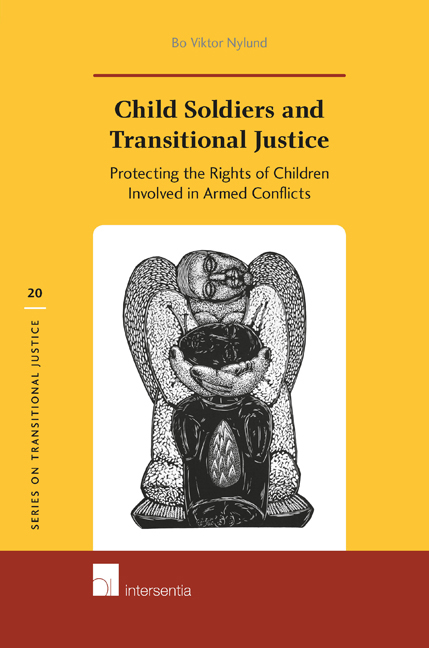 Child Soldiers and Transitional Justice
Child Soldiers and Transitional Justice Book contents
- Frontmatter
- Acknowledgements
- About the Author
- Contents
- List of Abbreviations
- Chapter 1 Objective, Scope, and Transitional Justice as an Analytical Framework
- Chapter 2 Child Recruitment and the Rule of Law: International Law and the Prohibition against Recruiting and Using Children to Take Direct Part in Hostilities
- Chapter 3 Child Recruitment and Criminal Justice: the Lubanga Case
- Chapter 4 Child Recruitment and Historical Justice: the Security Council Mechanism on Monitoring and Reporting
- Chapter 5 Child Recruitment and Reparatory Justice: Recovery and Reintegration of War-Affected Children
- Chapter 6 Child Recruitment and Institutional Justice
- Chapter 7 Children Involved in Armed Conflict and Participatory Justice: Balancing Rights and Responsibilities
- Chapter 8 Conclusions: Transitional Justice and the Potential for Stronger Protection of the Rights of Children Involved in Armed Conflicts
- Annexes
- Bibliography
Chapter 7 - Children Involved in Armed Conflict and Participatory Justice: Balancing Rights and Responsibilities
Published online by Cambridge University Press: 12 December 2017
- Frontmatter
- Acknowledgements
- About the Author
- Contents
- List of Abbreviations
- Chapter 1 Objective, Scope, and Transitional Justice as an Analytical Framework
- Chapter 2 Child Recruitment and the Rule of Law: International Law and the Prohibition against Recruiting and Using Children to Take Direct Part in Hostilities
- Chapter 3 Child Recruitment and Criminal Justice: the Lubanga Case
- Chapter 4 Child Recruitment and Historical Justice: the Security Council Mechanism on Monitoring and Reporting
- Chapter 5 Child Recruitment and Reparatory Justice: Recovery and Reintegration of War-Affected Children
- Chapter 6 Child Recruitment and Institutional Justice
- Chapter 7 Children Involved in Armed Conflict and Participatory Justice: Balancing Rights and Responsibilities
- Chapter 8 Conclusions: Transitional Justice and the Potential for Stronger Protection of the Rights of Children Involved in Armed Conflicts
- Annexes
- Bibliography
Summary
“They made you chop off an arm or kill someone in your family, then they gave you drugs to make you feel better, and then you did not care and you killed many more people.”
INTRODUCTION
Participatory justice is an area of transitional justice that includes elements of administrative and constitutional justice, but it has recently been viewed as a distinct field deserving focused attention. Although this field could be seen as a cross-cutting theme in transitional justice settings, participatory justice requires separate consideration in the context of child recruitment.
Participatory justice offers an opportunity for children to make a significant contribution to the various processes related to transitional justice. It is every child's right to be heard and to express her or his views and opinions, but participatory justice not only conveys rights to an individual child, it confers responsibilities.
The topic of child recruitment offers a particularly interesting paradox in the field of transitional justice: while child recruitment is defined as a war crime, children themselves may perpetrate human rights violations while serving as child soldiers.
Key legal questions that are considered in this chapter include:
– What does the law provide for more generally that can be applied to support children's participation in justice processes in a transitional justice context?
– What is the situation of children who have participated in the conflict and who may have carried out crimes while in the ranks of an armed group or force?
– In both those instances, what approaches are in the best interests of children and society as a whole, inclusive of protecting the rights of children while also considering their responsibilities?
It is critical to be clear about the objectives in the processes of participatory justice. Are we seeking ways and means through which children can recover and reintegrate, or looking for ways to hold children accountable? Do we want to warn future child soldiers against participating in armed conflicts? Or do we want to achieve all of the above? It is in the best interests of the child and the wider society that justice is approached with a view to restore and recover so that child soldiers are able to reintegrate.
- Type
- Chapter
- Information
- Child Soldiers and Transitional JusticeProtecting the Rights of Children Involved in Armed Conflicts, pp. 187 - 212Publisher: IntersentiaPrint publication year: 2016


